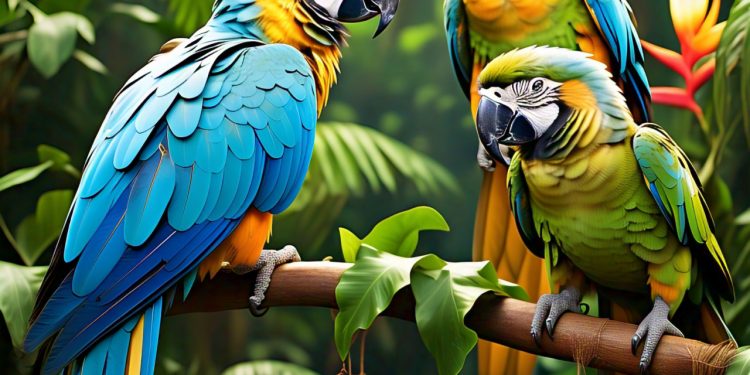Parrots are among the most fascinating and intelligent birds on the planet. With their vibrant plumage, exceptional mimicry skills, and playful personalities, they have captivated humans for centuries. But beyond their striking looks, parrots possess amazing cognitive abilities, social behaviors, and survival adaptations that make them truly unique.
In this article, we’ll explore fun and mind-blowing facts about parrots, including their intelligence, communication skills, unusual behaviors, and surprising evolutionary traits.
1. Parrots Can Live for Over 80 Years
Some parrot species, like the Macaw and African Grey, have incredibly long lifespans. Many parrots outlive their owners, making them lifelong companions.
🔹 The oldest recorded parrot was Cocky Bennett, a cockatoo that lived for 120 years!
🔹 African Greys and Macaws often live 40 to 80 years in captivity with proper care.
🔹 Smaller parrot species like budgies (parakeets) live around 5 to 15 years.
2. Parrots Are Some of the Smartest Animals on Earth
Parrots have problem-solving skills and self-awareness comparable to primates like chimpanzees and dolphins.
🔹 The African Grey Parrot is the most intelligent parrot species. One famous parrot, Alex, could identify objects, understand numbers, and even express emotions.
🔹 Parrots have been observed using tools, solving puzzles, and even tricking humans or other animals to get what they want!
🔹 They can recognize themselves in mirrors, a sign of self-awareness, which is rare among animals.
3. Parrots Have Complex Speech and Mimicry Abilities
One of the most well-known abilities of parrots is their capacity to mimic human speech and other sounds.
🔹 Some parrots speak with perfect clarity, mimicking words, phrases, and even accents.
🔹 African Greys can learn over 1,000 words, understanding context rather than just repeating sounds.
🔹 Parrots also mimic phones, microwaves, car alarms, and even dogs barking!
Why Do Parrots Mimic Sounds?
In the wild, parrots mimic their flock members to communicate. Captive parrots mimic human speech because they see their owners as part of their “flock.”
4. Parrots Have Zygodactyl Feet – What Does That Mean?
Unlike most birds, which have three toes facing forward and one facing backward, parrots have zygodactyl feet—two toes facing forward and two backward.
🔹 This unique foot structure gives them an excellent grip, allowing them to climb trees and hold objects like a hand.
🔹 Some parrots can even use their feet to grab food and bring it to their mouths—a rare ability among birds!
5. Some Parrots Are Brilliant Dancers
Parrots naturally synchronize their movements to music, which is an ability previously thought to be unique to humans.
🔹 The famous parrot Snowball, a cockatoo, became viral for dancing perfectly in rhythm to pop songs.
🔹 Scientists have confirmed that parrots can feel the beat and adjust their movements accordingly, something even chimpanzees struggle with!
6. The Kakapo Is the World’s Only Flightless Parrot
Most parrots are excellent flyers, but the Kakapo, a large, nocturnal parrot from New Zealand, is flightless.
🔹 Kakapos are the heaviest parrots in the world, weighing up to 9 lbs (4 kg).
🔹 Since they can’t fly, they climb trees using their strong legs and beaks.
🔹 They are critically endangered, with only around 250 left in the wild.
7. Parrots See More Colors Than Humans
Parrots have tetrachromatic vision, meaning they can see an extra color beyond human perception—ultraviolet (UV) light.
🔹 This allows them to spot subtle color variations in feathers, which helps them choose mates.
🔹 Some parrots have UV-reflective feathers that make them more attractive to potential partners.
8. Parrots Use Their Tongues Like Hands
Parrots don’t just use their beaks to manipulate objects; they also use their muscular, flexible tongues!
🔹 Their tongues have bones inside, helping them grip and manipulate food.
🔹 Some parrots, like Lories and Lorikeets, have brush-like tongues for eating nectar and pollen.
9. The World’s Smallest Parrot Is the Size of a Thumb
The Buff-faced Pygmy Parrot (Micropsitta pusio) is the smallest parrot species, growing only 3 inches (8 cm) long and weighing about 0.4 ounces (11 grams)—lighter than a AA battery!
🔹 They live in Papua New Guinea and feed mainly on fungi, lichens, and small insects.
10. Parrots Are Found on Every Continent Except Antarctica
Parrots are highly adaptable and can be found in rainforests, savannas, mountains, and even urban environments.
🔹 The highest-living parrot is the Kea, a mountain parrot from New Zealand that thrives in snowy conditions.
🔹 Some parrot species, like Monk Parakeets, have adapted to cities and live in parks and suburbs.
11. Some Parrots Form Lifelong Bonds
Parrots are incredibly social animals that form strong pair bonds.
🔹 Many species, such as lovebirds, mate for life and spend hours grooming each other.
🔹 They also mourn if their mate dies, showing signs of depression or loneliness.
🔹 Parrots rely on social interaction, and lonely parrots can develop self-destructive behaviors like feather plucking.
12. Parrots Have Incredibly Strong Beaks
A parrot’s beak is one of the strongest tools in the animal kingdom.
🔹 The Hyacinth Macaw, the largest flying parrot, has a bite force of 500 to 700 PSI—strong enough to crack a coconut or break a broomstick!
🔹 Their powerful beaks allow them to crack open nuts, tear apart fruits, and even defend themselves from predators.
Final Thoughts
Parrots are some of the most intelligent, social, and fascinating creatures on Earth. From their mimicry skills to their strong beaks and unique feet, these birds have evolved in extraordinary ways.
If you’re lucky enough to have a parrot as a pet, remember—they’re not just pretty birds. They’re emotionally complex, highly intelligent, and need lots of social interaction, mental stimulation, and proper care.
Did you learn something new about parrots today? Share this article with fellow bird lovers and spread the joy of these incredible creatures! 🦜✨

























